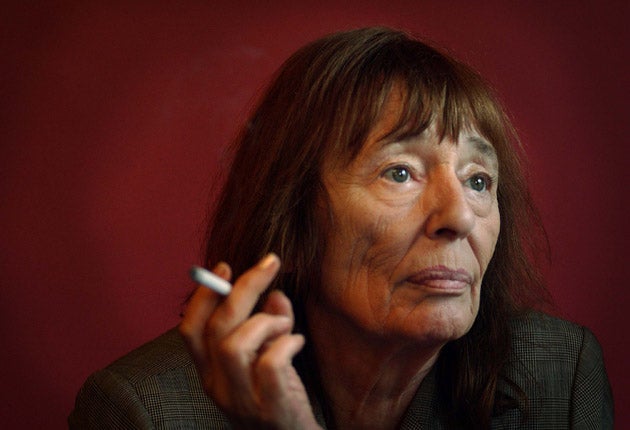The Girl in the Polka Dot Dress, By Beryl Bainbridge
Beryl Bainbridge's almost-finished but still frustrating final novel is a terse and pared back picaresque, set in the year of RFK's assassination

In Harriet Said (1972), Beryl Bainbridge's terrifying young anti-heroine remarks: "You see, I've read so many books now which just tell a story that I begin more and more to go after style, rather than dramatic content." The comment is a wind-up, masking the malice of a "clever, meticulous mind."
It is as good an introduction as any to Bainbridge's last box of tricks; a cabinet of curiosities stuffed with bizarre objects – but locked. This unfinished novel, the final instalment, will forever shut its door in our faces.
Bainbridge achieved the status of literary treasure in her lifetime but would surely have cast a wickedly beady eye on posthumous reverence such as the pointless "Best of the Booker" exercise. Her work, clever and meticulous as it is, deserves more than ritual genuflection. Those left unsatisfied by the coitus interruptus of her famously elliptical style will regard The Girl in the Polka Dot Dress as a fittingly frustrating finale to a stellar career.
Bainbridge was well-known for paring away content, which forced readers to puzzle and re-read. She enjoyed that process and its result. But this work (which ends apparently just 35 pages short of its author's target, and with nothing added by the editor) communicates sheer tiredness. It is not so much "spare" as exiguous.
Rose is a 30-year-old English woman who travels to America in search of the mysterious Dr Wheeler, whom she knew as a child growing up in the bleak, coastal area of the north-west familiar from Bainbridge's early novels. Did Rose accidentally cause the death of a tramp when she was young; an event witnessed by Wheeler? Probably, although the flashback crime scene is confused.
Waiting for Rose at the airport is Harold Grasse (also confusingly called Washington Harold), who met her briefly in England and has his own reasons to look for the man who stole his wife and caused her suicide.
This grubby, unlikeable pair, each haunted by the past and united in mutual misunderstanding and irritation, begin an odyssey from state to state in a camper van in search of the elusive Wheeler. They encounter oddballs and hazards on their journey – a picaresque lurching between grotesqueries reminiscent of O Brother, Where Art Thou? without the joy of the songs. Or, for that matter, the jokes.
The year is 1968. It turns out that Wheeler is in Robert Kennedy's entourage, which leads Harold and Rose (wearing her new polka dot dress) to the Ambassador Hotel, Los Angeles, where Kennedy is about to be assassinated. A foreign stable boy in a yellow sweater has already encountered them, and he pitches up at the hotel too. This is obviously Kennedy's actual Palestinian assassin Sirhan Sirhan, and once again, Bainbridge's fiction slides in alongside real history, to underline the randomness of events and the ordinary desperation of those who unwittingly play their part.
A contemporary conspiracy theory placed a girl in a polka dot dress at the scene shouting "We've shot him", and Bainbridge has taken this unidentified fragment of history as the lynch-pin of her plot. How would she have ended the story? Does Harold take a vengeful pot shot at Wheeler and hit Kennedy instead, thus giving credence to the second gun theory? Does Rose ever get to reunite with old Dr Wheeler? We shall never know.
For that reason alone it seems to me slightly misguided, even unfair, for the publishers to describe this as "a masterpiece". At her best, Bainbridge used language precisely. But here, the lack of true dramatic content and the perfunctory characterisation abandons you to style alone.
Students of Bainbridge's work will recognise familiar tropes, especially the wilful use of semicolons, dividing sentences from themselves, dispatching you enigmatically in another direction. But the laconic tone can seem careless. "She was called Philopsona, or something like that," simply does not work since we are with the authorial voice at that moment, not Rose's, and the author would know a character's name. At other times, the sudden shift from a character's personal tragedy to authorial detachment seems jarring, even merciless. So when Rose is recalling the baby she had at 16, given away for adoption by her mother, we gain no further insight into her pain, only the savage irony of: "Mothers could always be depended on to know what is best."
Recalling the autobiographical nature of her early work, it's fascinating to learn that, in 1968, Bainbridge travelled across the States with a man called Harold she hardly knew and with whom she did not get on. Her family has released extracts from the journal she kept, in which she notes: "Theme of the next novel should be a journey but in what form?"
In The Girl in the Polka Dot Dress we have the journey but with none of the lyrical beauty which illuminates that 1968 journal and her better novels. The journey is towards silence itself – leaving us with the sense of a turning away from memories unutterably sad, and therefore unspeakable.
To order any of these books at a reduced price, including free UK p&p, call Independent Books Direct on 08700 798 897 or visit independentbooksdirect.co.uk
Join our commenting forum
Join thought-provoking conversations, follow other Independent readers and see their replies
Comments